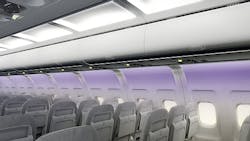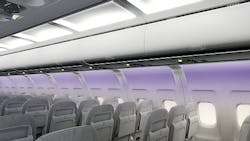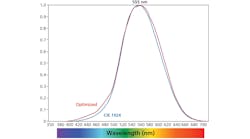Schott has announced that it has worked with Lufthansa Technik to develop next-generation aircraft-cabin lighting based on red, green, blue, and white (RGBW) LEDs, a light guide to uniformly distribute the light, and MAZeT color sensors to ensure that all LED modules deliver consistent color performance. Schott and Lufthansa demonstrated the HelioJet Spectrum technology at the recent Aircraft Interiors Expo in Hamburg, Germany, after Schott and MAZeT had initially demostrated an early version at the LED Professional Sympoisum last fall.
Indeed, solid-state lighting (SSL) technology has opened up new dimensions of technological options and creativity. Still, there are problems to solve with LEDs such as color and brightness issues, when coping with drift effects resulting from age, temperature, binning, or caused by technological system differences. MAZeT and Schott worked together on HelioJet using the former's color-sensor technology to eliminate uniformity issues.
The technological benefit in the example of airplane cabin lighting is significant as such a plane will be flying for the next 25 year while the lighting modules are exposed to a harsh environment. When looking at operating times of more than 50,000 hours, temperature shifts during takeoff, travel, and landing and even in the cabin present an extreme environment for traditional LED technology.
HelioJet technology was first used to overcome the phenomenon of aging white LEDs in aircraft cabins. Rather than placing numerous LEDs in a line, it works with only two LEDs per lighting element, which feed light from the two ends into an optical light converter or guide. Based on fiber-optic principles, the converter mixes the light and distributes it evenly over the entire distance of the light element. This enables the module to provide unmatched homogeneous light -- not only when new LEDs are installed, but continuously over time. The light mix in the converter overcomes the problem of aging LEDs by reducing it to an indiscernible effect. The new technology also enables controlled light output by accurately adjusting the light and aperture angle. The light is no longer emitted in every direction, providing new possibilities for precise light design solutions. Since the European aviation authority (EASA) issued a supplemental type certificate (STC) for the Airbus A320 family, white-light HelioJet technology has been lighting the cabin in an Airbus A319.
With the introduction of the technology for white cabin light, the question of using it for colored light arose. The answer is HelioJet Spectrum, an RGBW version with True Color Stabilization (TCS). HelioJet Spectrum gives 16 million color shades -- offering almost unlimited possibilities for mood lighting and corporate color themes.
MAZeT 's True Color sensor and signal processing technology are based on interference filters with human-eye accuracy and enable results at a quality level never matched before. Accurate and stable CCT or color dimming over the long term without aging or other drift effects are no problem for this technology. HelioJet Spectrum also works with an optical light converter. At each end, four LEDs feed in light, which is mixed in the optical light converter. Since color LEDs are much more heterogeneous than different shades of white, it also includes a special sensor-based controller technology, which ensures that every LED installed in the system is perfectly in tune with the specified setup and accurately produces the desired color temperature. The controlling system does more than manage the LEDs in one HelioJet Spectrum unit; it also controls all of these units in the cabin. For instance, the lighting can be controlled by Lufthansa's cabin management system.
"We have received extremely positive feedback from potential customers," said Armin Plichta, general manager of transportation at Schott Lighting and Imaging. "This confirms that we are on the right track. We expect the qualification phase for HelioJet Spectrum to be completed in the second half of 2014."
There are a number of potential benefits for color lighting in applications such as aircraft cabins ranging from simply improved aesthetics to better wellbeing for passengers. For example, Osram, Airbus, and other researchers demonstrated that tunable lighting can deliver passengers that are more refreshed after long-range international flights.
There is a question as to whether you would need a color sensor in a state-of-the-art LED lighting product for consistency, however, as SSL technology has greatly matured. Cree, for example, was among the earliest companies to mix off-white and red LEDs in fixtures in what it called TrueWhite technology to deliver 90-CRI performance at high efficacy levels. Early on, Cree TrueWhite products included color sensors to ensure consistency because the red LEDs suffered lumen depreciation at a different rate from the white LEDs. The sensors enabled real-time correction. These days, though, companies such as Cree have shown that they have sufficient documentation about the lumen-maintenance performance of white and RGB LEDs that an intelligent controller can simply modify drive currents over time based on testing data and still maintain good uniformity.







